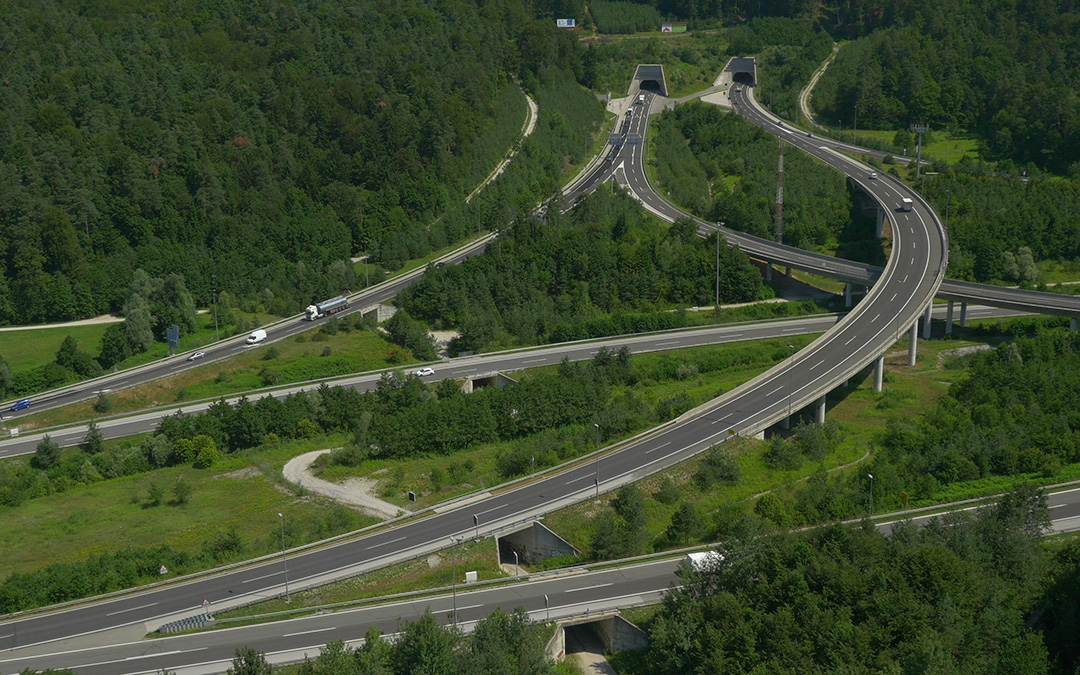Efficient, competitive and well integrated into the European market – this is how Slovenian road freight transport can be characterized. It makes a significant contribution to the gross domestic product and offers many secure jobs.
Slovenia is an important transit country – not only for holidaymakers on their way to Italy, Austria, Hungary and Croatia, but also for all kinds of goods. Because the desired shift to rail has stalled, most goods are transported by road.
Investment in the infrastructure
The road network in Slovenia had a total length of 38,800 kilometers in 2021. 616 of these were freeways (in 2003 there were not even 500), 5,925 were main or national roads and 32,259 were secondary or regional roads and unpaved roads. The fact that the turnover in Slovenian road construction is forecast to rise from 679.7 million euros in 2014 to 842.94 million euros in 2025 shows how much the country is currently investing in its infrastructure.
 Slovenia continues to expand its road infrastructure. Photo: iStock
Slovenia continues to expand its road infrastructure. Photo: iStock
In 2020, the transport industry in Slovenia generated a turnover of around 6 billion euros. Road freight transportaccounted for around 3 billion euros of this. This sector also employed the most people in 2020 – around 29,000 people. The total number of employees in the Slovenian transport and logistics industry amounted to around 48,000 in 2021, and the industry’s turnover rose to a record 8.5 billion euros in 2022.
In 2024, the Slovenian transport market is expected to have a freight volume of 8.87 billion tonne-kilometres. Land transport will account for 8.87 billion tonne-kilometres of this. The volume of goods transported in road freight transport in Slovenia is expected to amount to 2.62 billion tonne-kilometres in 2024, with the entire transport market accounting for 8.87 billion tonne-kilometres. This is expected to generate added value of more than 3 billion euros. At the same time, the market for third-party logistics is becoming increasingly important in Slovenia, as more and more companies are outsourcing their logistics. Turnover in this area is expected to reach EUR 717 million in 2024 and rise to EUR 805 million by 2028, which corresponds to an annual growth rate of 2.93%. Total logistics costs in Slovenia are expected to reach 8.3 billion euros by 2028.
What characterizes road freight transport in Slovenia
- Central location: Slovenia is located at a strategically important crossroads between Central and South-Eastern Europe. It connects major transportation routes between the Adriatic ports and the Central European domestic market as well as between Western and Eastern Europe.
- Infrastructure: Slovenia has a well-developed road network. The most important highways are the A1, which runs from the Austrian border via Ljubljana to Koper, and the A2, which connects Slovenia with Croatia and Hungary. These highways are part of the Trans-European Transport Network (TEN-T).
- Logistics centers: Slovenia has several modern logistics centers and industrial parks that enable efficient distribution and storage of goods. Important logistics centers are located in Ljubljana, Maribor and Koper.
- Port of Koper: The port is a central hub for international trade and plays a key role in freight transportation. It is the most important Adriatic port for the transportation of containers and goods in Central and Eastern Europe.
- Neighbors: Slovenia borders on the neighboring countries of Italy, Austria, Hungary and Croatia. The many border crossings are crucial for transit traffic and international trade.
Balanced foreign trade
Slovenia exported goods worth around 65 billion euros in 2022 and imported roughly the same amount. The most important export goods were medical and pharmaceutical products with a share of 29.3 %, followed by road vehicles (8.6 %) and electrical machinery (7.7 %). Medical products accounted for 15.5 % of imports, organic chemicals for 10.2 % and petroleum products for 8.7 %. The main export countries for Slovenian goods in 2022 were Switzerland (21 %), Germany (14.5 %) and Italy (10.6 %). Most imports came from Switzerland (15.4 %), China (11.9 %) and Germany (10.5 %). The most important products were medical and agricultural products (29.3 %), food (8.6 %) and electrical machinery and equipment (7.7 %).
What have you already brought to or picked up from Slovenia? Write a comment!


0 Comments